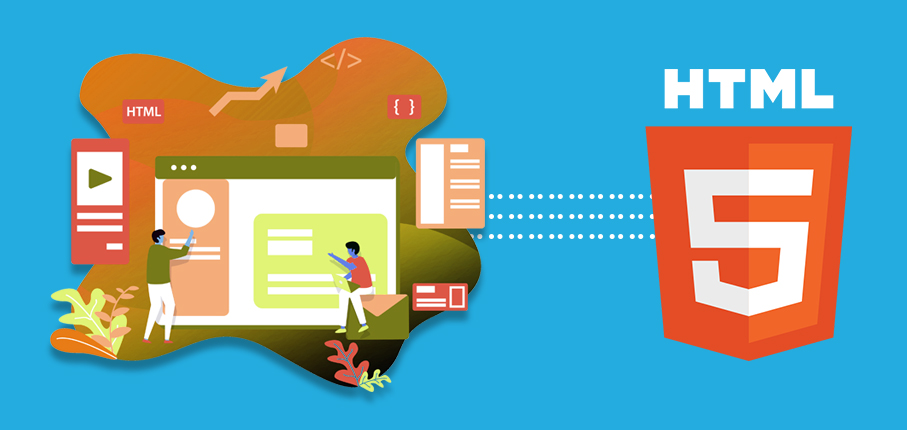Why HTML5: Features, Advantages, and Benefits of HTML5

“HTML5- An Evolution, not the Revolution”, W3C
HTML(Hypertext Markup Language), has been the paradigm as well as the most popular language for website development with 5 successful versions already under its hood. HTML5, the latest and a more progressed version considered in this series, with some modifications and new features incorporated in it. With newer version upgrades popping out with time, the users feel tormented with the mere thought of switching to the upgrade. This time tasking action eventually holds them back from opting for the upgrade.
The World Wide Web Consortium(W3C), the developer of HTML series, understands this and has consequently tailed it in its latest development that is HTML5, promising to make the switch easier. HTML5 has not only improved the structure of code but also facilitated you with many other features and tags such as Cross-Browser compatibility, Multimedia related tags, Animation tags, Offline browsing, etc. With these features, HTML5 has become even more versatile and the best pick for emerging technologies in this field.
Here are some of the substantial reasons to opt HTML5 for your project:
Cleaner Code Structure
HTML5, with so many altered as well as new tags, has improved the code structure making it cleaner and lucid for both programmers and non-programmers. Like, <div> tag, that is one of the most extensively used HTML tag has been supplanted by various tags such as <article>, <section>, <figure>, <header>, <footer>, and <nav>, preventing you from getting lost in code.
For Example:
“div#header, div#footer{…}“ is written as “header, footer{…}“
“div#content{…}” is written as “section{…}”
“div.article{…}” is written as “article{…}”
“div#menu ul{…}” is written as “nav ul{..}”
Cross-Browser Compatibility
Instead of restricting to a single platform/browser, HTML5 has introduced a new cross-browser compatibility feature, being supported by popular versions of multiple web browsers. To include this feature on your website, list down the elements of the target browsers and then address them individually through fallback and graceful degradation. Let’s say if a feature of your website is not supported by a browser, better to display a customer-friendly text to make the problem comprehensible, creating the fallback, thus gracefully degrading the website as per the browser elements.
Audio and Video Tags
Playing media files on a browser was a bit complex task with the previous versions of HTML, requiring you to install supporting multimedia software such as Flash and use some complex tags like <embed> and <object>, to play it.
HTML5 liberates you from this with its <audio> and <video> tags, which is used just like the other HTML tags. You can use these tags and modify their attributes such as controls, loop, autoplay, muted, src, height, width, etc, accordingly.
For Example:
<audio controls>
<source src=” ” type=” “>
</audio>
Offline Browsing
The availability of the internet cannot be promised for 24*7, which can sometimes hinder your work as well. HTML5, with its manifest attribute included in the <html> tag, enables the users to continue browsing the webpages and web applications even in the offline state.
The manifest attribute directs the Uniform Resource Identifier to a ‘manifest’ consisting of the files that should and shouldn’t be cached, to avail them to the user when offline. The structure of the manifest consists of 2 sections:
- CACHE MANIFEST: includes the files that have to be cached like index.html, CSS file, logo and background images, etc.
- NETWORK: includes the files that shouldn’t be cached and misused such as server.cgi.
No More Cookies
Cookies, a secret weapon of the website to track its users and deliver personalized services to them, have been an important thing for the websites throughout. But its setback cannot be denied, making your data risk-prone and increasing the server load as well. HTML5 Web Storage, by replacing the cookies, has addressed all these problems. It provides 5 MB storage space at the client-side to store the data, which is not send over the server making it more secure than the previous versions and hence, reducing the server overhead.
Canvas for Animation and Game Development
Flash, a software used for dynamic websites and applications, has become deprecated due to its limited functionalities and setbacks. Being an external software embedded in the HTML code, Flash cannot interact directly with the HTML elements and requires the browser to install a dedicated plugin to function.
To reduce the hassle and bring the animation to another level, HTML5 came up with a new tag called <canvas>. Canvas, a feature embedded in HTML5 and a part of Document Object Model(DOM), opens multiple animation options, enabling you to draw graphs, add visual effects, develop games both online as well as offline, etc. on the web page.
Conclusion
Website Designing has never been so innovative yet simple.
HTML5, with its so many astounding features as mentioned above, has transformed the entire website development process. HTML5 has gained a lot of popularity since its introduction and has become the choice of many popular organizations for their websites.
Without much ado, it is favorable to shift to HTML5 and forget about the difficulties associated with your website like browser compatibility, complex codes, etc. You can hire an HTML5 developer from Ace Infoway to help you in this transformation and develop an ideal website. For any further query, feel free to Get In Touch with us.
Originally posted by Ace Infoway. Read the original blog at https://www.aceinfoway.com/blog/html5-benefits-and-features


Comments
Post a Comment